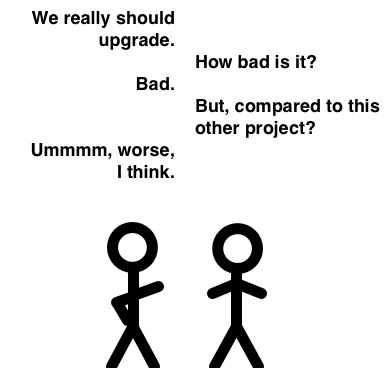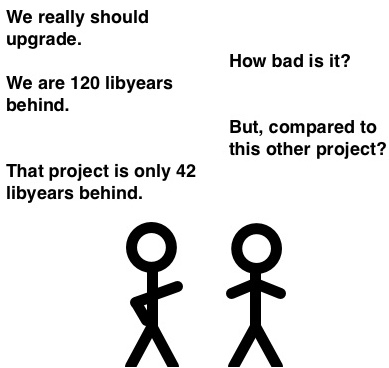libyear
A simple measure of software dependency freshness. It is a single number telling you how up-to-date your dependencies are.
Example
Rails 5.0.0 (June 2016) is 1 libyear behind 5.1.2 (June 2017).
Simpler is Better
There are more nuanced ways to calculate dependency freshness. This approach is simple. You can explain this calculation in 30s.
Download / Tools
- dotnet (NuGet) - dotnet-libyear
- js - libyear (GitHub Action: libyear-node-action)
- php (composer) - php-libyear
- python (PyPI) - pylibyear
- python - piprot (since 2013)
- ruby (bundler) - libyear-bundler
- java (Gradle) - libyear-gradle-plugin
- java (Maven) - libyear-maven-plugin
- java (CLI + Maven) - Maveniverse Toolbox
- scala (Maven and SBT) - release
- go (modules) - go-libyear
- rust (Cargo) - cargo-libyear
- common lisp - ocicl
- your favorite - contributions welcome
Before

After

Example 2
If your system has a one year old dependency and a three year old dependency, then your whole system is four libyears old.
A Healthy App
At Singlebrook we try to keep our client’s apps below 10 libyears. We regularly rescue projects that are over 100 libyears behind.
Etymology
"lib" is short for "library", the most common form of dependency.
Other Measurements
libyear-bundler implements some of the other metrics
described by (Bouwers, Eekelen, Visser, 2015).
The --versions flag provides a metric for an installed
dependency’s freshness relative to the newest release’s major, minor, and
patch versions. Of course, this is most useful for dependencies that
follow a consistent versioning scheme such as semver.
The --releases flag provides a metric for the number of
releases between an installed version of dependency and the newest
released version of the dependency.
Each metric has it’s own advantages and disadvantages, and all quantify the maintenance burden for an app. Taken together, they can help prioritize maintenance for an inherited app, or help maintain a baseline level of dependency freshness for an ongoing project.
References
- J. Cox, E. Bouwers, M. van Eekelen and J. Visser, Measuring Dependency Freshness in Software Systems. In Proceedings of the 37th International Conference on Software Engineering (ICSE 2015), May 2015 https://ericbouwers.github.io/papers/icse15.pdf